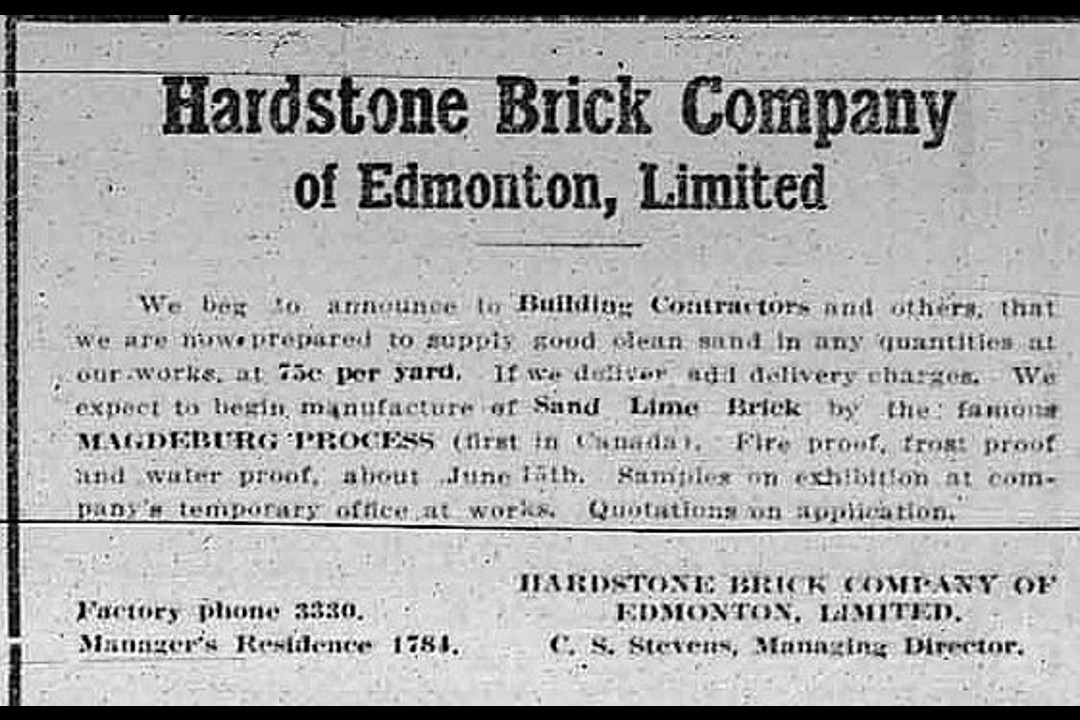On this day in 1912, the Hardstone Brick Company was pumping out bricks that would help build the city.
In Edmonton's early years, the city's river valley looked far different than today. In the late 1800s and early 1900s, the banks of the North Saskatchewan River housed much of the city's industry. There you would once find lumber mills, coal mines, meat-packing plants, and other businesses that took advantage of the valley's natural resources and used the river to transport their wares by boat.
Brickyards were also common along the river. Ample deposits of clay provided the materials, while coal mined nearby fuelled furnaces to harden the bricks. But one of Edmonton's early brickyards took a slightly different approach. In 1907, the Pressed Brick Company purchased a bit of land on the riverbank in what's now Cloverdale from Cornelius Gallagher (the namesake of the park where the Edmonton Folk Music Festival is held each year). The land contained sand — a lot of sand. Instead of the traditional baked-clay bricks other brickyards were making, the Pressed Brick Company mixed the sand with lime brought in on the Edmonton Yukon and Pacific Railway. The result was sand-lime bricks, which proved to be stronger, cheaper, and faster to make.
Pressed Brick began producing bricks at the perfect time. Edmonton's population was skyrocketing. The demand for new schools, churches, and homes was strong, and they all needed to be made out of something. Sand was dug out of the ground uphill from the brickyard and carried down to be processed. Then, the finished bricks were taken further downhill, and loaded onto boats, horse-drawn carts, or railcars. The bricks are still viewable in several buildings constructed during the period, including the Alberta Legislature Building and The Bennett Centre.
Gallagher returned to this story in 1912, when he and several investors purchased the brickyard and renamed it the Hardstone Brick Company. The brickyard had by then become a high-tech operation for the time. Automated machinery and a connection to the city's relatively new electrical grid let it continue production in the evenings and the winter months, when some brickyards had to shut down. By 1912, Hardstone could produce five million bricks a year.
But the success didn't last. The need for bricks began to wind down as Edmonton's rapid growth slowed, which was only made worse when Canada went to war in 1914. But it was the devastating flood of 1915 that brought the true end for the Hardstone brickyard. In June of that year, water levels were incredibly high in the river valley, washing away more than 50 buildings — including many of the industries along the river. Hardstone was high enough along the bank to remain standing, but the flood badly damaged the equipment inside. Attempts to restart production were made, but eventually the business was liquidated sometime around 1920.
But though the brickyard might be gone, the land it was built on remains forever changed. The quarries and piles created while gathering sand for bricks left behind hills and depressions on the site. Over the past century, the area has been reclaimed by aspen and poplar trees. In 1986, the environmentally sensitive area was designated as Camel Hump nature reserve (likely named for its lumpy terrain.)
In recent years, the City of Edmonton has explored the future of the area. In 2019, they started public consultation on a plan that would guide the future of Gallagher Park, including the Camel Humps.
This clipping was found on Vintage Edmonton, a daily look at Edmonton's history from armchair archivist @revRecluse of @VintageEdmonton.

